RECOIL OFFGRID Gear Review: PWS MK107 MOD 2-M 7.62×39 Pistol
For those living the prepared lifestyle, ammunition shortages during a time of crisis are one of the biggest concerns. It’s ideal to have stockpiles of ammunition on hand prior to such events, but if the situation is bad enough, those stockpiles will eventually be depleted. You could find yourself scrounging for whatever ammunition you can find. Having a gun that runs on a food source that’s highly available and effective for survival use will up the odds in your favor should the SHTF.
5.56 NATO is plentiful and easy to find in the United States, but it has some disadvantages. Although the 5.56 NATO has a flat trajectory and is fairly accurate over distance, its energy bleed-off limits its application to smaller game. Barrier penetration is also limited with this light and fast round, and ballistics suffer when used in a short-barrel weapon, which is probably what you’ll want in a SHTF scenario where mobility is key to survival.
Having originated in the former Soviet Union as an intermediate cartridge, the 7.62×39 is one of the most used cartridges throughout the world today. Ammunition is plentiful and ranges from steel-cased, FMJ surplus to high-grade, polymer-tipped variations, with bullet weights ranging between around 122 to 150 grains. Many excellent 7.62×39 loads, including hunting and defensive rounds, are available — please see Issue 26 of RECOIL for a buyer's guide.

The 7.62×39 has been highly regarded as an excellent close-quarters round. On average, the 7.62×39 produces about 220 foot-pounds more muzzle energy than the 5.56, giving it a distinct advantage in kinetic energy delivered on target that continues out to about 200 yards. It also offers better ballistics out of a short barrel and a lot more power for penetrating barriers, making it an effective round for close-quarters combat applications.
Primary Weapons Systems (PWS) has combined the usefulness of the 7.62×39 in a compact and trusted platform with their newly upgraded MK107 MOD 2-M Pistol. With its potential as a grab-and-go weapon that packs the punch of a .30-caliber projectile in bountiful supply, the “Diablo” as it has been nicknamed, demanded our attention. Here are our observations and what we learned when we put pin to primer.
The MOD 2-M upper features a forged 7075 aluminum receiver with handsome aesthetics. Forged aluminum is stronger than cast or billet because of the continuous grain structure that results during the forging process, so this is a definite plus for the MOD 2-M.
The 7.75-inch Isonite QPQ-finished chromoly barrel with a 1-10 twist is capped off with a PWS CQB Compensator. The CQB Comp was developed for military and law enforcement units operating indoors and in close proximity, and specially designed to redirect sound forward rather than to the side like most compensators. This feature not only improves overall weapon control, but also keeps you on speaking terms with your friends and teammates when you have to shoot next to them.
The barrel and piston system are housed inside a free-floating handguard that incorporates Primary Weapons Systems’ PicLok technology. This unique handguard design provides M-LOK mounting capabilities along the sides and bottom with integrated Picatinny rail segments on the forward portions for direct mounting of hard products. This keeps the handguard very sleek by having rail where you need it most, while offering room for expansion as needed.
The forged MOD 2-M lower receiver is enhanced with recessed ambidextrous controls that are thoughtfully placed in intuitive locations. These include a left-side magazine release lever located just in front of the trigger guard and a right-side bolt release placed slightly above and to the rear of the magazine release. A Radian Talon ambidextrous safety selector completes the ensemble with a modular short/long throw lever that can be modified from the standard 90 degrees to a 45-degree short throw.
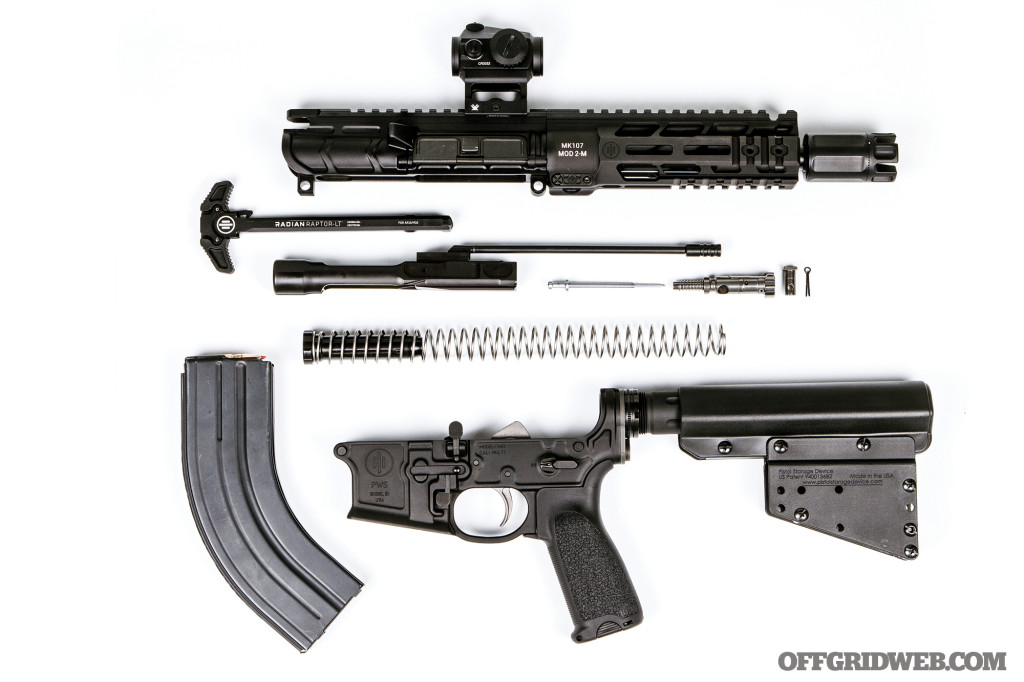
A disassembled view of the MOD 2-M reveals the configuration of the PWS long-stroke piston operating system.
The driver seat of the MOD 2-M is a BCM Gunfighter Grip Mod 3, which offers a reduced angle and high-rise beavertail backstrap for improved ergonomics and trigger control. A BCM polished nickel teflon enhanced Mil-spec trigger assembly offers a crisp pull and clean reset with zero over-travel. PWS also went the distance and eliminated the traditional pinned AR flat trigger guard in exchange for a solid, oversized trigger guard.
The buffer tube is covered with a Pistol Mounted Solutions Pistol Storage Device, which can be configured to store a variety of items, such as a secondary magazine, tourniquet, IFAK, etc. According to a BATFE ruling, it doesn’t change an AR pistol’s classification to a short-barreled rifle (SBR), even if used to brace the pistol against the shoulder.
The MOD 2-M uses the PWS long-stroke piston operating system. For those who might not be familiar with this type of operating system, it's similar to the direct impingement system found on most AR-style rifles. However, rather than being channeled through a gas tube where it proceeds to act directly upon the bolt carrier, the hot gas created when the weapon is fired moves into a gas chamber, where it acts upon the front of a piston to drive the bolt carrier to the rear.
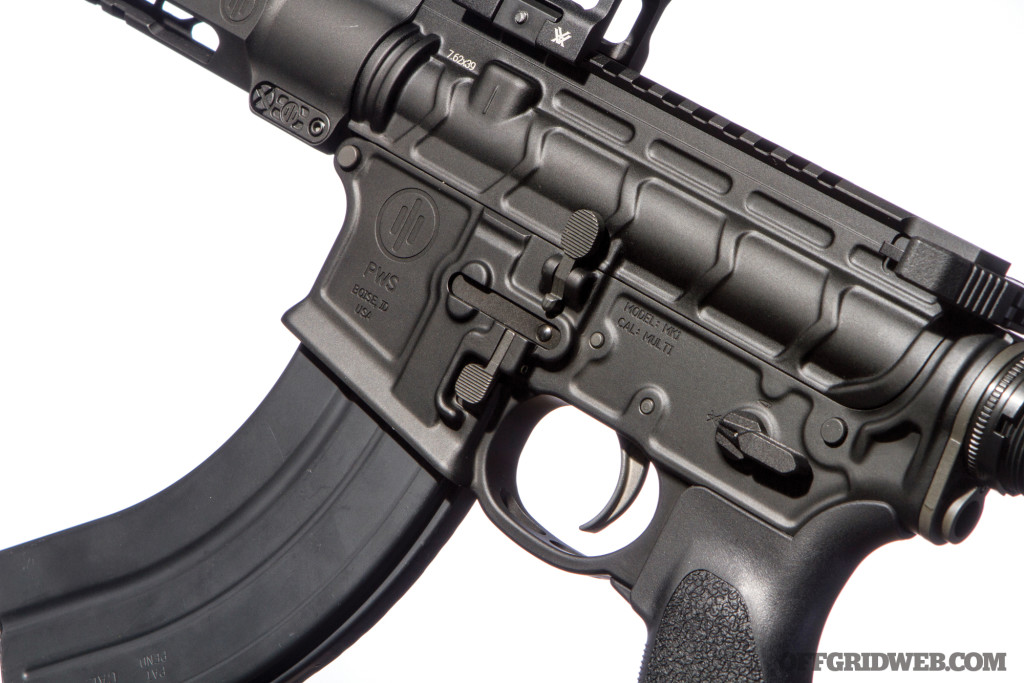
Intuitively placed ambidextrous controls improve functionality for right- and left-handed operation.
The MOD 2-M has a three-position adjustable gas system to function correctly with gas pressures that can vary with ammunition and suppressor use. Position 1 is the default position used when firing unsuppressed. Position 2 is for running low-power ammo through a suppressed barrel. Position 3 is for normal suppressor use with standard-power ammunition, or when running high-powered ammunition. This feature allows you to fine-tune the gun’s gas system for optimal performance.
What might be one of the best features on the entire gun is the enhanced buffer tube with a ratcheting castle nut. The castle nut is a weak point on the AR platform. It keeps the buffer tube and the lower receiver end plate in place. With this design, the castle nut ratchets against a detent, eliminating the need for staking.
Rounding out the ambidextrous design of the MOD 2-M is the Radian Raptor charging handle. The Raptor allows you to cycle the bolt using your palm or thumb-and-finger from either side of the gun, while its V-shaped design is less likely to catch on your kit than some of the other upgraded charging handles on the market.
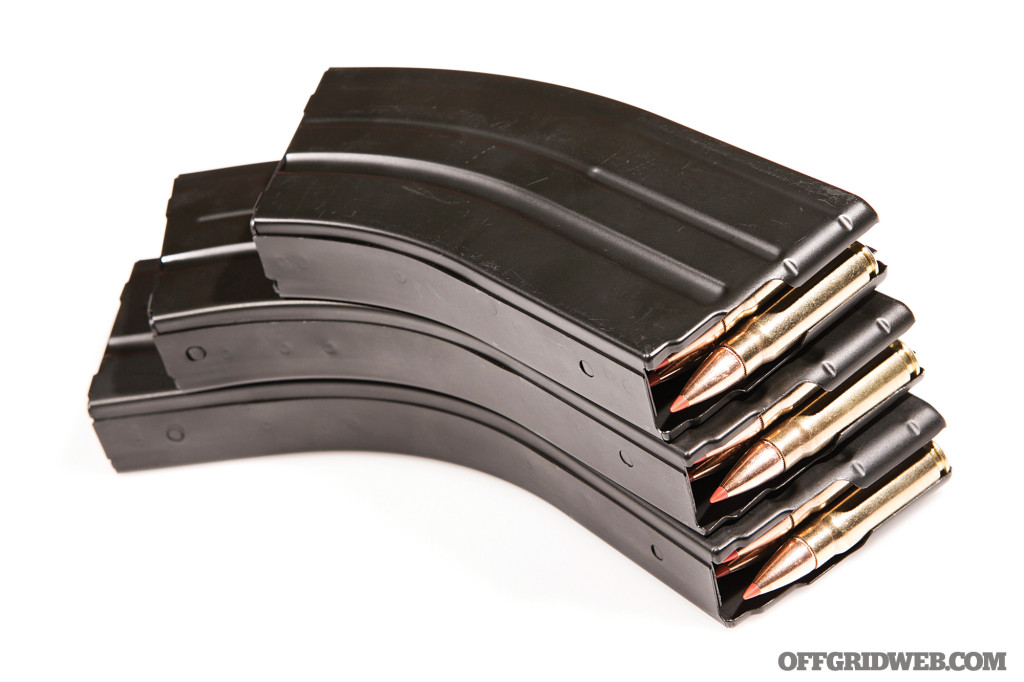
The 20-, 28-, and 30-round 7.62×39 magazines from C Products Defense provided a reliable feeding system for the...
One thing AR enthusiasts are sure to notice is the elimination of the forward assist from the MOD 2-M receiver. While this is sure to stir controversy among die-hard SPORTS fans, PWS concluded after over 10 years of piston system testing that the forward assist is unnecessary. Most schools of modern gunfighting have gotten away from the tactic of forcing the bolt forward in favor of a more diagnostic approach, so the absence of a forward assist shouldn’t be an issue. For the occasional press check or to quietly chamber a round, the bolt carrier can be assisted into battery using the original AR forward assist, the thumb notch on the bolt carrier group.
We paired the MOD 2-M with a Vortex Crossfire 2 MOA red dot sight before heading to the range. This proved to be a good match, as our windage was almost centered right out of the box. All we had to do was come up 4 inches in elevation, and we were dead on at 25 yards.
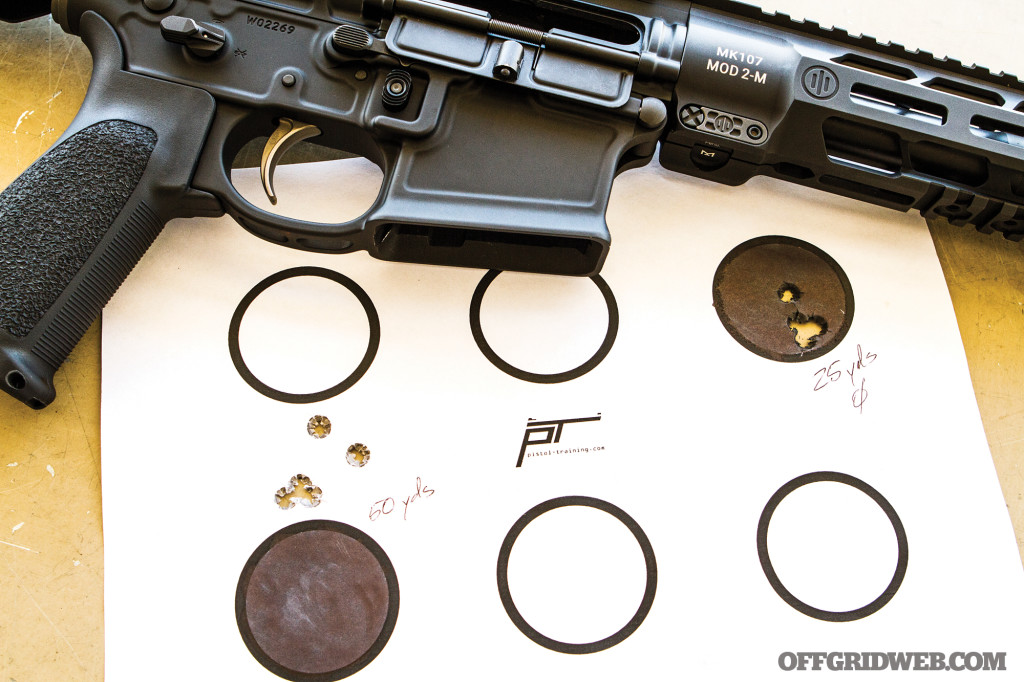
The MOD 2-M shot groups under 2 MOA at 50 yards and 2.5 MOA at 100 yards out of its 7.75-inch barrel using 123gr...
Hornady sent us a few hundred rounds of their premium 123gr SST Black ammunition, along with some 123gr SST Steel Cased ammunition to use in our testing. Both yielded excellent accuracy results out of the MOD 2-M. At 25 yards, we consistently shot one-hole, five-round groups that measured 0.5 inch at worst. Those groups widened just a tad when we moved to 50 yards, our worst group holding a 1-inch spread.
After moving back to the 100-yard line, we dropped our elevation 6 MOA to put us in the bull’s-eye and shot numerous five-round groups. Accuracy at this range held at roughly 2.5 MOA. Given this weapon’s configuration, we were plenty pleased.
Although the gun itself shot and functioned very well, the weakness in the platform is definitely the ammunition source. The 30-round Ammunition Storage Components magazine provided with the gun had some issues right out of the gate. Fifteen rounds was the most we could comfortably load into it.
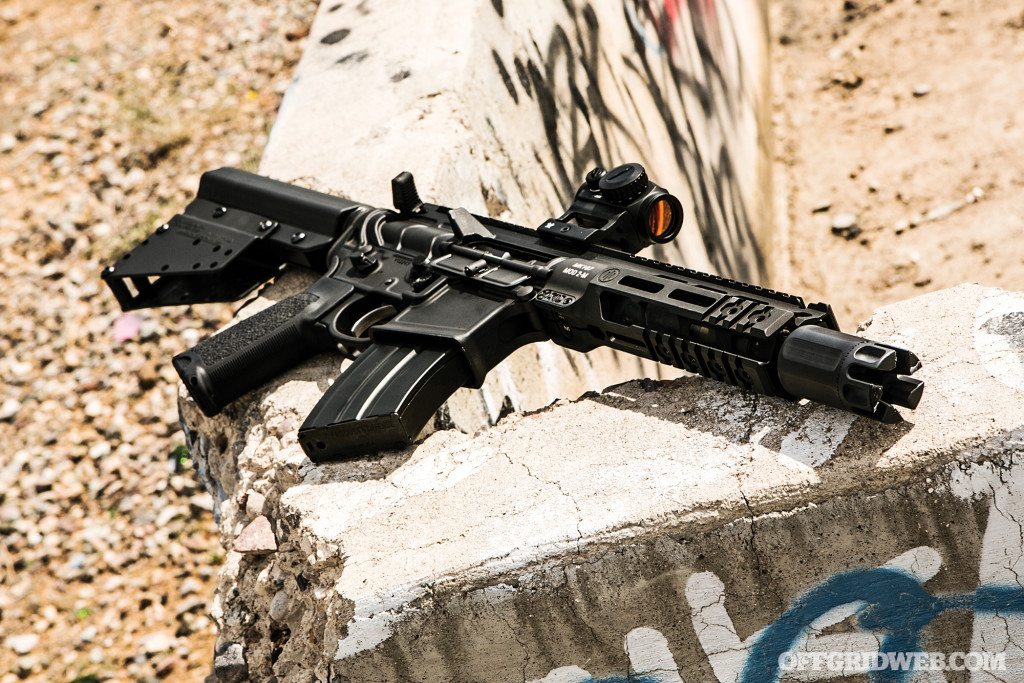
The MOD 2-M in full bug-out configuration with the Vortex Crossfire Red Dot sight and C Products 20-round magazine for...
With a lot of persuasive spine-tapping and brute force, we were able to cram 25 rounds inside, but the magazine didn’t like that one bit. The spring and follower would bind up, allowing rounds to fall freely out of the magazine. As a result of these magazine issues, the gun experienced multiple failures to feed during initial live-fire testing. PWS was quick to replace the bad magazine after we notified them about the problem. The two new ASC mags they sent loaded to capacity and ran pretty well aside from an occasional failure to feed that was quickly remedied with a tap and a rack.
Running 7.62×39 out of modified AR magazines has posed a significant challenge over the years with these types of 7.62×39 ARs, undermining confidence in them for defensive or survival use. One of the problems that doesn’t want to go away is the tendency for the cartridge rims to hang up on the extractor grooves of the cartridges below. Giving the mag a couple of good raps on the spine during loading to seat the cartridges all the way to the back helps prevent this issue. Some new mags require a break-in period before they'll hold a full complement of rounds. Even afterward, depending on the individual magazine, 28 rounds might be the max functional capacity of a 30-rounder.
To be as thorough as possible, we obtained three additional magazines from C Products Defense, one of the only other manufacturers of 7.62×39 AR magazines. They sent us a 30-, 28-, and 20-round magazine. These magazines performed exceptionally well with the MOD 2-M. Each one loaded smoothly and to full capacity right out of the box, running without a single malfunction. They would definitely be our magazines of choice for this particular platform. Stock up on them — you won't find a lot of these mags as battlefield pickups, so you'll need to hang on to and take care of them in a crisis situation.
The repeated malfunctions with the original defective magazine gave us a chance to operate the ambidextrous controls to their full extent. The ambi controls are placed to give the left-handed shooter the luxury of operating the gun in a manner that closely mirrors right-handed operation, providing optimal ergonomics no matter which hand you use. Ripping the magazine out can be done with one hand if necessary, since the left-side mag release is located in front of the trigger guard, midline with the trigger. This makes for an easy transition from the bolt catch (left side only) to the mag release when locking the bolt to the rear during a malfunction, since the right hand is occupied with the charging handle.
The PWS MK107 MOD 2-M Pistol is an excellent choice for a grab-and-go weapon. Paired with a discreet carrying case like the Hazard 4 Dropshot “tennis racket” case, the MOD 2-M Pistol can be easily carried through an urban setting without drawing unwanted attention. Once you get your magazines sorted, the terminal ballistics and abundance of 7.62×39 ammunition, the reliability and ergonomics of the trusted AR platform, and the quality delivered by Primary Weapons Systems are a hard combination to beat when all hell breaks loose.
Whether you’re looking for a compact weapon to have on hand as part of your bug-out supplies, or a trunk gun to add some additional firepower to your get-home plan, take a look at the MK107 MOD 2-M Pistol.
PWS MK107 MOD 2-M
Caliber
7.62×39
Barrel Length
7.75 inches
OAL
24.75 to 28.25 inches
Magazine Capacity
30
Weight
5 pounds, 10 ounces
MSRP
$1,850
URL
primaryweapons.com (also available at fortresstactical.com)
Magazine
C Products Defense – cpdmags.com
Case
Hazard 4 Dropshot – $140 – hazard4.com
Don’t miss essential survival insights—sign up for Recoil Offgrid's free newsletter today!
Read articles from the next issue of Recoil Offgrid: Issue 29
Read articles from the previous issue of Recoil Offgrid: Issue 27
Check out our other publications on the web: Recoil | Gun Digest | Blade | RecoilTV | RECOILtv (YouTube)
Editor's Note: This article has been modified from its original version for the web.
 STAY SAFE: Download a Free copy of the OFFGRID Outbreak Issue
STAY SAFE: Download a Free copy of the OFFGRID Outbreak Issue
No Comments